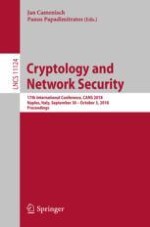2018 | Buch
Cryptology and Network Security
17th International Conference, CANS 2018, Naples, Italy, September 30 – October 3, 2018, Proceedings
herausgegeben von: Dr. Jan Camenisch, Panos Papadimitratos
Verlag: Springer International Publishing
Buchreihe : Lecture Notes in Computer Science
